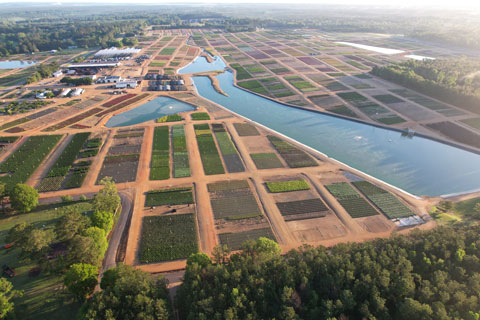8/1/2024
Trendy Plants
Rayne Gibson

Staying ahead of the curve is essential for sustained success. However, every year, with breeders coming out with their own special-new-exciting-shining-star that’s essential for you to grow because of its superior qualities and dazzling display of color and affinity for whatever climate you put it in, it’s become very difficult to figure out what items to bring on. Balancing what you “want” to grow versus what you “need” to grow.
Pictured: New trials planted at Gainous Shade Trees, Inc.
For growers, the challenge often lies in knowing when and how to introduce these new items into production. This process, while daunting, can yield significant rewards when approached strategically. Here, we outline a roadmap to help you navigate this journey, ensuring that your nursery remains competitive and thriving.
1. Start with your customers
The first step in bringing new items into production is understanding your market’s desires. Your core customers are a valuable and often under-utilized resource, offering insights into emerging trends and unmet needs. Conduct surveys, hold focus groups and engage in those hard and direct conversations to gather feedback on what new products they’d like to see. This not only makes customers feel valued, but also provides a solid foundation for your decision-making process.
“The initial feedback is seen by bid sheets and requests from customers—that’s the easiest way to see true demand,” said Thurman Main of Blue Heron Nursery. “Also, we are fortunate that we have a lot of people come for a tour here and the surrounding nurseries. I will ask them, ‘What’s the coolest thing you saw today?’ or ‘What are the top items that you are needing and looking for this year?’ I hop out of the van and immediately make a note of it.”
2. Assess production capabilities
Once you have a clear idea of what new items to introduce, it’s crucial to ensure your production team is equipped to handle the change. Assess your current resources, including labor, equipment, physical space and expertise. Too often the sales team drives the conversation without bringing the production team into the fold. This step is vital to avoid overextending your capabilities and ensures that the quality of your existing products (and your teams wits) aren’t compromised. Collaborate closely with your production managers to evaluate whether new investments are necessary.
Questions for leadership to ask:
■ Do you need additional training for your staff?
■ Are we familiar with how to grow this type of plant?
■ Do we have the space?
■ When should we get these in?
■ How long do you think it will take to bring them to market?
Address these questions early to lay the groundwork for successful integration of new items.
3. Test with a sample crop
Before committing fully, run a pilot program with a sample crop. This allows you to experiment on a smaller scale, mitigating risk and providing valuable data. Monitor the growth, health and market reception of the new items. Use this phase to iron out any potential issues, ensuring that when you scale up, you’re well prepared.
During this testing phase, document everything meticulously. Keep detailed records of growth patterns, pest resistance, water and nutrient requirements, and any other factors that could affect large-scale production. Engage your production managers in this process to gather their hands-on insights and feedback.
Additionally, involve your sales team early on. Get their input on potential market reception and pricing strategies. Their close relationship with customers can provide invaluable foresight into how new items might perform commercially.
Continuously gather customer feedback during this phase as well. Offer early access to loyal customers and request their honest opinions. Their insights can guide final adjustments and help shape marketing strategies.
I asked Michael Roe, VP of Production at Windmill Nursery in Louisiana, to tell me about his process of trialing and deciding if his production team can handle growing a new plant well.
“We typically bring in a liner tray or two and pot the plants up into the field right alongside our other crops,” he explained. “We don’t treat the new plants any differently than the plants we currently have in our production mix. If it can’t grow out there under the same irrigation schedule, fertilizer rate, spray program, etc., then it probably won’t make the cut. If it performs well through at least one full year, and through all the seasons, then the sales team will look at it, make their evaluations and decide whether or not to add it into our production master plan. In the case of Ternstroemia Crown Jewels, which we developed here at the nursery, we evaluated that plant for over 10 years before deciding it was worthy of obtaining a patent for it.”

4. Scale up strategically
With successful test results in hand, the next step is to scale up production. This should be done incrementally, using data and feedback from your production managers, sales managers and customers. This feedback loop is crucial; it allows you to make informed adjustments and ensures that the introduction of new items aligns with market demand and operational capacity.
Begin by increasing the scale of production in manageable increments. This phased approach allows you to address any unforeseen challenges without overwhelming your resources. It also provides opportunities to refine processes based on real-world performance data.
Pictured: Every growing space is treated as a trial bed at Windmill Nursery LLC.
Maintain regular communication with your team throughout this phase. Hold weekly meetings to review progress, discuss any issues and make necessary adjustments. Foster a collaborative environment where team members feel comfortable sharing their observations and suggestions.
5. Leverage marketing
In today’s market, savvy marketing can accelerate the adoption of new products. Highlight the unique benefits and features of your new items. Use social media, email newsletters and in-store promotions to generate excitement and educate your customers. By effectively communicating the value of your new products, you can create demand and foster quicker acceptance.
Develop a comprehensive marketing plan that includes engaging visuals, compelling narratives and targeted outreach. Showcase the unique qualities of your new products through high-quality images and videos. Share behind-the-scenes stories of the development process to create a connection with your audience.
Utilize multiple marketing channels to reach a broader audience. Leverage social media platforms to share updates, run promotions and engage with customers. Use email newsletters to keep your loyal customers informed and excited about new offerings. Consider hosting events or webinars to introduce new products and provide a platform for customer interaction.
6. Embrace experimentation and risk
One of the biggest hurdles in introducing new items is overcoming the comfort of the familiar. It’s easy to stick with what’s always worked, but this mindset can limit growth. Encourage a culture of experimentation within your team. Be willing to trial and fail without remorse. Each failure is a learning opportunity, bringing you one step closer to success.
Cultivate an environment where experimentation is encouraged and rewarded. Celebrate the lessons learned from failures as much as the successes. This positive reinforcement will motivate your team to keep innovating and exploring new possibilities.
Encourage open communication about the results of experiments. Share both the successes and the failures with your entire team, creating a collective learning experience. This transparency fosters a culture of continuous improvement and resilience.
“We got used to growing the same thing year after year,” said Johnson Gainous of Gainous Tree Farm. “Bringing on new product for us was very rare, but we have taken on more in the last four years than ever before.”
Conclusion
Introducing new items into production is a strategic process that requires careful planning, execution and a willingness to take calculated risks. By listening to your customers, ensuring your production capabilities, testing thoroughly, scaling up strategically, embracing experimentation and leveraging marketing, you can innovate successfully and keep your business at the forefront of the horticulture industry.
Remember, the journey of innovation is continuous. Stay curious, remain flexible and always seek to improve. Your willingness to adapt and evolve will pave the way for long-term success and sustainability. GT
Rayne Gibson is a horticulture graduate from Louisiana State University and brings extensive experience in the green industry, serving in various capacities helping businesses across the southern U.S. He also served on the boards of the Louisiana and Texas Nursery Landscape Associations.